Would you believe us if we tell you that axolotls always stay babies their entire lives? You read that right! They stop developing beyond their larval phase. Despite the fact that they are nearly extinct, they also rank among the most desirable exotic species sold on the market.
Those of you who have had an axolotl are aware of their special housing and water needs, which might be difficult for many beginners to fulfill.
This article will cover all the details required for providing optimal care for baby axolotls – tank requirements, breeding, temperament, diet, and possible health concerns.
What Is a Baby Axolotl Called?
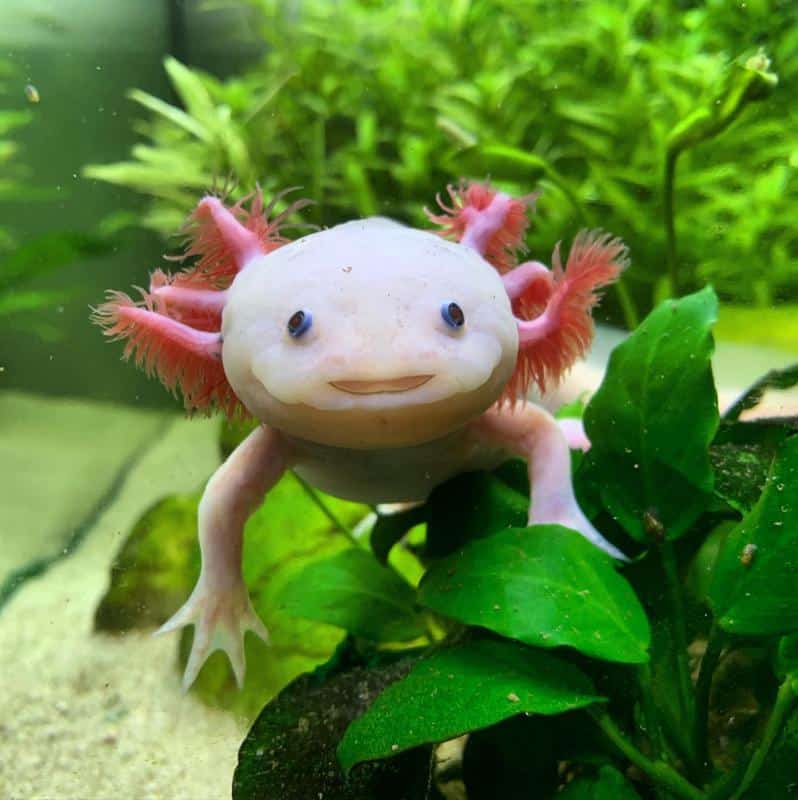
A juvenile axolotl is classified as a larva! The offspring of axolotls belong to the salamander group. They emerge from eggs coated in mucus and need approximately two weeks to mature.
They do not metamorphose like similar salamanders. They stay in the larval stage their entire lifetime. The scientific term for this process is the neuroanatomical stage.
There are other species than axolotls whose offspring are referred to as larvae. According to researchers, every creature that experiences a new phase of life in order to enter maturity is considered a larval. Frogs that evolve from tadpoles to adults are an excellent illustration of this type of creature.
What Do Baby Axolotls Look Like?
Axolotls have the distinctive characteristics of the salamander larval stage: exterior gills and a posterior fin that extends from the back of its head to its end.
Axolotls, on the other hand, are neotenic salamanders, which indicates they retain features from youth into maturity. Age-related gill loss occurs in many salamander species but never in axolotls.
A completely evolved mature axolotl would have 3 sets of gills slits (rami,) including filaments (fimbriae) to help in breathing that is positioned at the back of its head. Axolotls are known for their cute smiles, which are formed due to their big, broad heads.
They possess long, delicate, weak limbs with smaller eyes that lack lids. Males are recognized by their expanded cloacae, which are papillae-lined (the organ that excretes waste). Females often have slightly bigger bodies.
A grownup axolotl (both male and female) get completely evolved at 18-24 months of age and have a size varying from 6 to 18 inches (average size is 9 inches). They may weigh up to 10.5 oz (300 grams).
A native axolotls’ appearance could be a mixed brown, emerald, and yellow with lavender gills.
Baby Axolotl Care
A newborn axolotl is comparatively a simple salamander to take care of. It requires a filtration system and clean water, just the same as a fish. Axolotl babies need specific care since they are highly susceptible to water conditions, humidity, and aquarium oxygen supply.
As a result, you must fulfill their tank needs properly and monitor the water quality to maintain them fit and energetic.
Tank Requirements and Set-Up
An adorable baby axolotl doesn’t require much room. Also, grown axolotls can thrive in crowded conditions. Both their metabolism and level of activity are slow in all these salamanders.
You may keep your exotic animal in a 10-gallon water tank; however, a 20-gallon container would be the safest and easy to maintain.
Axolotls often excrete considerable wastes, so providing them with a bigger water body may help maintain the water conditions in your aquarium steady. Ground area (length and width) should be prioritized above height. Therefore, a 20-gallon container is what you need.
Sand or empty surface are your two substrate possibilities. Axolotl tanks with empty surfaces are simple to manage, but if your companion can’t hold onto something on the surface, it might get depressing for them.
The most suitable and secure substrate for axolotls is sand. Sand grains are microscopic and won’t create any major issues, even if your pet consumes them. Axolotls enjoy digging and playing with the sand since it helps improve their health and prevents them from becoming depressed.
Then, you may add a little greenery to your aquarium, like java grass, anubia barteri, and horword, as they are excellent choices, as well as crevices and other hideaways (PVC cuttings or clay pots).
Although axolotls don’t need any special lighting, intense lights might stress them out. The ideal option is to use a tank LED light since you can adjust the intensity.
Water Requirements
To improve the lifespan, happiness, and health of your baby axolotls, it is essential to provide suitable water conditions.
- Temperature: 60-70°F (15-23°C)
- pH: 6.5-8.0
- Chlorine: 0 ppm
- Ammonia: 0 ppm
- Nitrite: 0 ppm
- Nitrate: 0-10 ppm
- Water Hardness: 7-14 GH
- Carbonated Hardness: 3-8 KH
How Do Axolotls Breed?
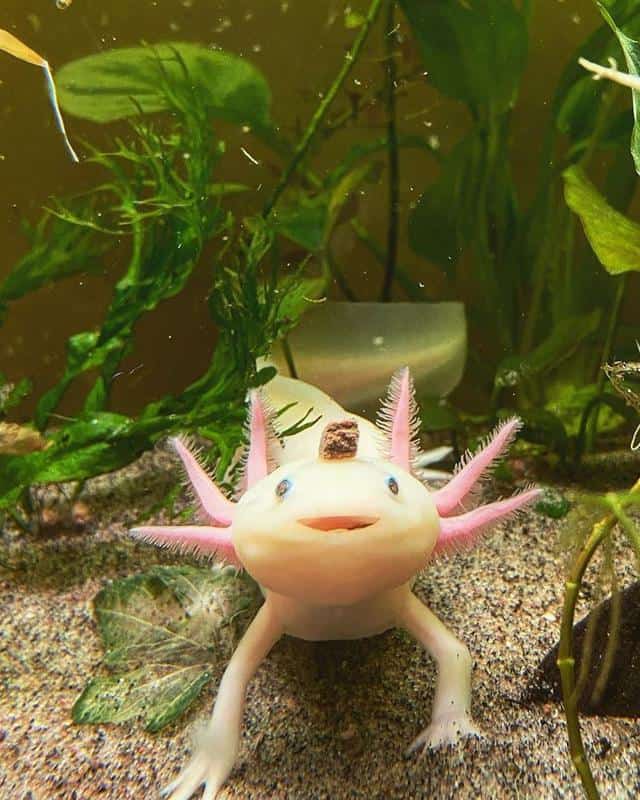
Axolotls mate throughout the late cold season and early summer season. Once prepared to reproduce, the male and female would engage in a ritualized mating process. Then the male will insert a spermatophore, meaning a capsule of testicles, while he pushes the female in one direction. The procedure is referred to as indirect implantation.
Fertilization occurs quickly because females often lay their eggs 12 to 72 hours after implantation. Although female axolotls have the potential to produce up to 1500 eggs, you must separate the adults and the eggs.
You should remove both the adult and the eggs when the cycle is over. These animals can not resist consuming their eggs.
Some breeders like to transfer eggs into different tubs while keeping adult axolotls in their original aquariums. Axolotl eggs are quite tough making them easier to move to another container.
With your fingertips, gently slice the eggs’ exterior sticky coating to release the eggs. You do not have to be concerned about cracking the eggs since they are surrounded by multiple layers of mucus.
Eggs deposited on the plantation are the easiest to extract; simply remove the plants from the tank and grab the eggs.
It’s paramount to understand that eggs would grow more quickly in higher temperatures whether you opt to keep them in your hatching container or move them to the parents’ tank. Eggs develop within 15 to 21 days, depending on the warm water temperature.
Keeping the water temperature within 70 degrees Fahrenheit (21 degrees Celsius) would lead to fastening the hatching period.
What Do Axolotls Eat?
Axolotls are omnivores, consuming whatever they can swallow completely, including bloodworms, insects, bugs, tiny fish, and other animals.
You will have to provide similar food to axolotls if you have them. They may be given a diversity of living and dead foodstuffs. Such as:
- Angleworms
- Bloodworms
- Brine shrimp
- Frozen fish pellets
- Skudge Worms
- Standard fish food
- Small pieces of beef
Offering wild-caught things is not recommended since they could contain parasites. Axolotls may be fed by dropping food near the animal while holding rounded tweezers. You might also simply add a few insects or pellets around their position. Frozen diet or commercial pellets are much easier to feed. They don’t require any vitamin or mineral supplements.
To prevent contaminating the water, dispose of any leftover food after a few hours. Feed a newborn or juvenile axolotl every day. The serving quantity should be around four tiny bugs.
You should feed your larval and younger axolotls daily two times. Grownup axolotls should be fed every 2 to 3 days. A mature axolotl could survive for 14 days without any food.
Behavior, Temperament & Tank Mates
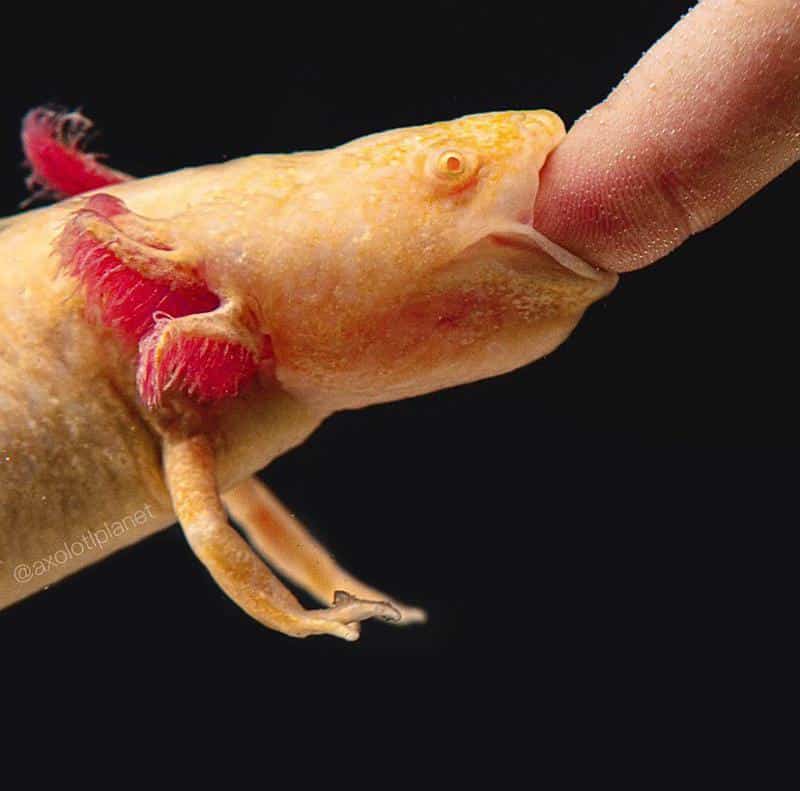
Axolotls are fascinating creatures to observe since they are usually more energetic during the night or in soft-lit areas. Since they are typically sloppy species, they dedicate the majority of their time sitting at the tank surface.
But don’t be fooled by their welcoming personality, big smile, and overall charm. Axolotls are ferocious carnivores who will consume literally everything.
As a result, housing an axolotl around some other species, amphibians, shrimp, and perhaps other animals, is never a good idea since they tend to bite, nip, and swallow their prey without any warning.
Due to the risk of significant injury from nipping one another’s fins and limbs, juvenile axolotls (measurements 8 to 16 cm) should never be kept together. If you have the expertise and feed them correctly, it might be acceptable to house them with each other.
However, grownup axolotls that have achieved maximum size may live harmoniously and hardly engage in fights. Nevertheless, as axolotls are lonely amphibians, adding a second axolotl in the aquarium won’t help. It is best to keep axolotls in isolation.
7 Common Health Issues
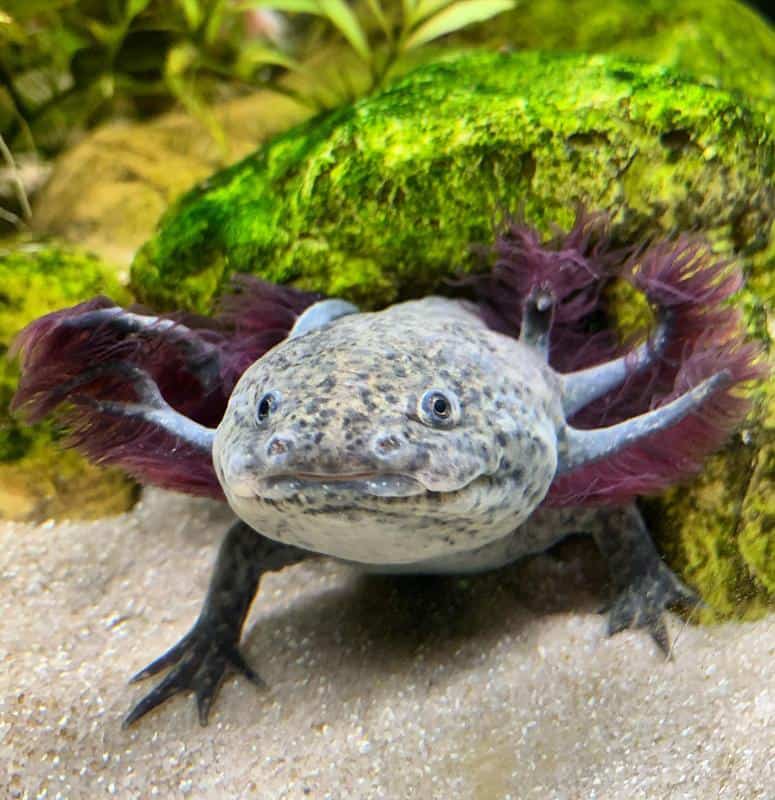
Despite being strong animals, axolotls are prone to a variety of diseases. The following list includes several health problems that might harm young axolotls.
Exophthalmia
Exophthalmia, often known as protruding eyes, is among the health concerns that could affect newborn axolotls.
An axolotl’s protruding eye is typically a sign that it has been dealing with increased nitrate concentrations for a long time.
A protruding eye might also mean that your animal is evolving as a result of bad water parameters.
This condition may be addressed by frequently replacing the tank water. You may also purchase a filtration system to assist in maintaining optimum water quality.
Hyperthermia
Hyperthermia is a medical problem in which your axolotl overheats as a result of exposure to hot water. If the water temperature is raised over 73F or 23C, newborn axolotls could develop hyperthermia. Additionally, overheating might result in a drop in the aquarium’s oxygen levels and trigger viral infections.
Hyperthermia could be treated by lowering the tank’s water temperature. You can quickly provide relief to your pet by cooling it down. But, if your axolotl has a bacterial infection, you may have to start antibiotic medication. Getting a container cooling device to assist keep the aquarium of your axolotl consistently cold is an excellent approach to avoid this.
Overfeeding
Axolotls can control how much food they eat; they can also overeat. Baby axolotls who are overfed may develop obesity and other serious health issues, and in the worst circumstances, they may even die.
It is possible due to the fact that young axolotls could experience digestion problems as a result of their inability to properly process their food.
One effective remedy is to provide your axolotl a little quantity of food that they would devour within 1-3 minutes. By doing this, you can make sure that you’re giving them the proper nutrition.
Underfeeding
Among axolotls, underfeeding is generally less harmful than overfeeding. But, underfeeding may cause malformed development and slow maturation in newborn axolotls.
In severe circumstances, underfeeding might also risk young axolotls to various disorders. Axolotls could be treated for the nutrient deficiency by giving them healthy food every day.
Skin Infections
Pustules and abscesses are chronic skin illnesses that harm your young axolotls. Young axolotls’ skin infections are normally triggered by poor water conditions in their tanks, although pathogens could also be responsible.
Maintaining your young axolotl in an aquarium with clean water might help you prevent skin diseases.
Injuries
Your infant axolotls might experience wounds like losing a limb, beautiful gills, a small section of their mouth, etc. It typically happens when you have many axolotls in a single aquarium. The axolotls are capable of attacking and sometimes even eating one another.
If an axolotl gets wounded in its aquarium, you may heal it by separating it from the other animals. In order to minimize future accidents, you should also take away any displays or enclosures with sharp corners from the aquarium.
Floating Upside Down
Baby axolotls may also experience moving upside down, which is a significant health concern.
It often happens as a result of methane buildup in their guts, stress brought on by bad water conditions and warmth, not being able to process the food, and gastrointestinal blockage.
You can bring your pet back to the surface by scaring it. If they come down, then they might be experiencing gas.
Related:
- GFP Axolotl Guide: Why Glowing, Care & Diet
- Fish With Legs: Unique Walking Fish
- Can You Hold or Touch an Axolotl?
- Axolotl Tank Setup
- Can Axolotls Go on Land?
FAQs
How Much Does an Axolotl Baby Cost?
A newborn axolotl may cost anywhere between $30 and $75, based on the source location. The pricing range depends on factors like fitness, length, color, etc. Some rare varieties might cost $100 or maybe more.
How Long Do Baby Axolotls Live?
They can live for a maximum of 15 years, but their average lifespan is around 10 years.
How Can You Differentiate a Male Axolotl from A Female?
Males are larger in size and have an enlarged cloacal area. Females have wider, fuller bodies to store eggs.
Conclusion
Axolotls are one-of-a-kind because of their charming, broad smiles and cute personality. It might be difficult for beginner fish keepers to look after newborn axolotls.
But, looking after newborn axolotls could be a great experience if you invest enough time to give the proper tank, nutrition, and water conditions for your pet.
They do not have any specific requirements, but they do not do well in bright lights. You should also keep your axolotl alone as they can be aggressive towards their own kinds and other small species.
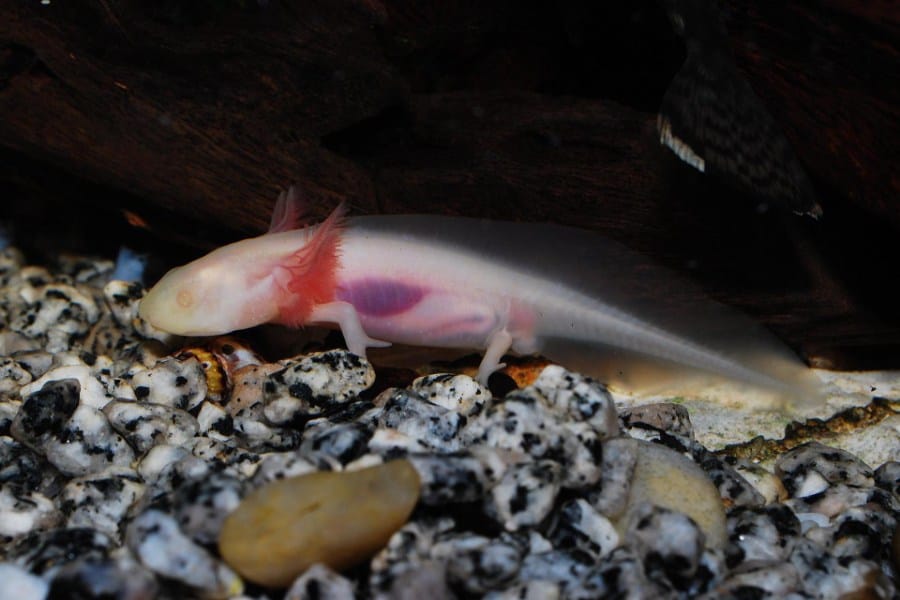
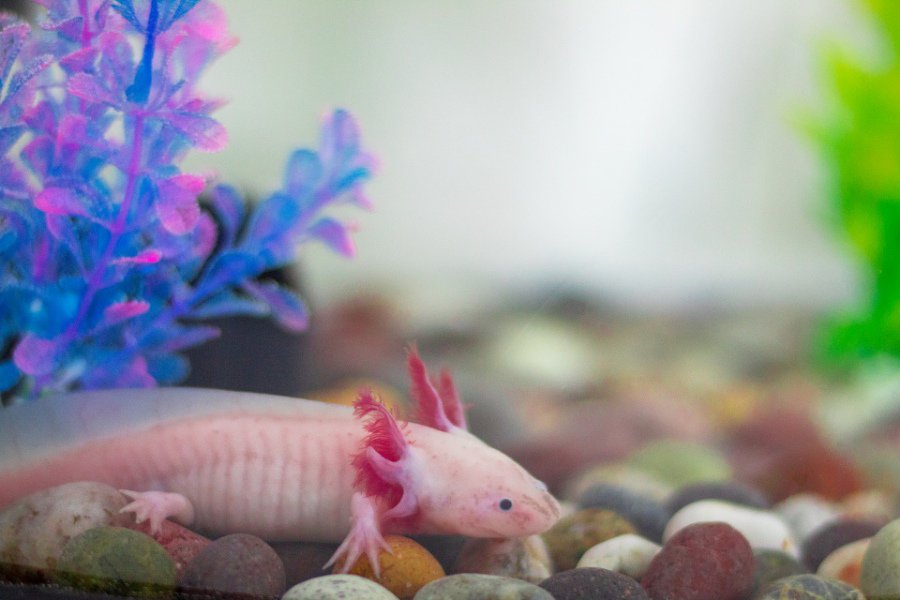
This was really helpful for me to do my research paper on.